|
 |
| Delhi Jaipur Tour |
|
Delhi Jaipur Tour India
Duration: 2 Night / 3 Days
Destination: Delhi-Jaipur
Day 1: Delhi
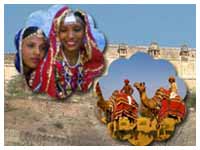 Arrival at delhi airport / railway station by our representative, and transfer to hotel, later visit india gate, pm house, humayuns tomb, red fort, qutab minar, gandhi memorial, jama masjid. Overnight at the hotel.
Day2: Delhi-Jaipur-265 km
After breakfast drive for jaipur, on arrival check into hotel, later visit albert hall, hawa mahal, jantar-mantar, city palace, water palace and amber fort. Overnight at the hotel.
Day 3: Jaipur
Moorning free at leisure and intime transfer to airport / railwation. tour lend with sweet memories. |
TOP TOURIST PLACES IN JAIPUR, RAJASTHAN :- |
Jaipur, the capital of Rajasthan is a wonderful tourist attraction in Rajasthan. Jaipur India is given a world wild title, as the Pink City due to the pink wash applied to its buildings. Travel to Jaipur - the capital city of Rajasthan, it is an abode of extensive boulevard and beautiful gardens. Jaipur India was founded by Sawai Jaisingh II, in 1727 AD, still preserves its glory of rich history and culture.
Rajasthani jewelry, art and fabrics maintain an ageless feature and are surely a treasure-trove for the shoppers. These exquisite items are of great demand in the international market. Jaipur Tourism with its romantic grace takes one to an era of kingship and heritage. Travel to Jaipur, one of the most treasured destinations of Rajasthan.
The royal fervor can be evidently experienced from the ancient monuments dotting the city, lifestyle of the people, culture and the food. Surrounded by three magnanimous forts, carpeted with lush gardens and splashed with serene lakes, a visit to Jaipur is a sheer delight for visitors. To know some of the major tourist attractions and places to see in Jaipur, read on. |
The Hawa Mahal or the 'Palace of Winds:
Hawa Mahal is the main landmark of Jaipur,built in 1799, by Maharaja Sawai Pratap Singh, is the most recognizable monument of Jaipur. This five - storey building, which looks out over the main street of the buzzing old city, is having 953 windows with over hanging latticed balconies is a fine piece of Rajput architecture. Originally designed for the royal ladies to watch and enjoy the processions and other activities, on the street below. Timing 10.00 to 16.30 hrs. |
 |
City palace of Jaipur :
The City Palace located at the heart of the city best exemplifies the cultural legacy of the royal past it was built by Kachchwah Rajput rulers of Jaipur. The City Palace is a classic example of Mughal and Rajput architecture. A part of the palace today is museum that houses a collection of rare manuscripts, weapons, Mughal carpets and costumes, and Mughal and Rajasthani miniatures. Diwan-E-Am (Hall of public audience) has intricate decorations and collection of manuscripts, Diwan-E-Khas (Hall of private audience) has a marble pawed gallery Mubarak Mahal has a rich collection of costumes and textiles. There is a Clock Tower near Mubarak Mahal. Sileh Khana has a collection of armory and weapons. Timing 9.30 to 16.45 hrs. |
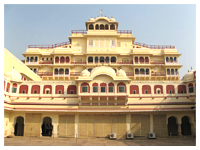 |
Jaigarh Fort:
Jaigarh Fort is one of the few intact forts in the state of Rajasthan. The fort located some 15 kms from the city centre of Jaipur is one great attraction for the tourists.
Jaigarh Fort was built by Sawai Jai Singh in the year 1726.it standing on a hilltop, overlooking the palaces and city of Amer. The world’s biggest cannon on wheels- the Jai Ban is positioned here, built during reign of Maharaja Sawai Jaisingh. It has a twenty feet long barrel and pumped in the cannon for a single shot. Timing 10.00 to 16.45 hrs, Phone: +91-141-2630848
|
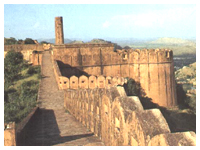 |
Nahargarh fort:
Gracing the rugged ridge of the Aravalli Hills is the Nahargarh Fort build by Sawai Raja Jai Singh.(15 kms.) Cresting a hill about 600 ft. above the city, the fort was built in 1734. A 9 km road runs up through the hills from Jaipur, and the fort can be reached along a zigzagging 2km path which starts from the north - west of the old city.Inside the fort you can visit the Madhavendra Bhavan housing the nine apartments of Maharaja Ram Singh's nine wive. Timing 10.00 to 16.00 hrs, Phone: +91-141-5148044
|
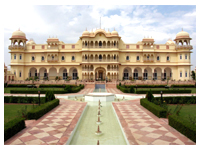 |
Amber Fort:
Popularly known as the amer fort, it is one of the most magnificent monuments, situated on the outskirts of the city.amer was the old capital of the kachhwahas stands atop a range of craggy hills. It is a fine blend of Hindu and Muslim architecture. The solemn dignity of its red sandstone and white marble pavilions, when reflected in the lake at the foot hill, is a sight to behold. Amber as it exists now is the handiwork of three of the kingdom's rulers that include man singh, and jai singh I and II.
The palace complex is lavishly ornamented and displays the riches of Amer. Sheesh Mahal chamber of Mirrors. Diwan-e-Am or the Hall of Public Audience is a beautifully proportioned hall open on three sides and stands on two rows of ornamented pillars. Diwan e-Khas or the Hall of Private Audience has delicate mosaic work in glass. Sukh mandir is guarded by sandalwood doors inlaid with ivory. Throughout the massive fort finely carved lattice windows, exquisitely painted doorways, halls and finely sculptured pillars crave for attention.
Timing: 9.00 to 16.30 hrs. Phone: +91-141-2530293 |
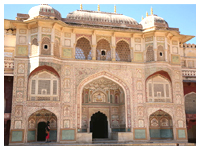 |
 |
|
Albert Hall:
Central Museum or the Albert Hall lies in the Ram Niwas Garden. It is a vast and verdant garden housing a zoo, a greenhouse, an aviary, a museum and a sports ground. Maharaja Sawai Ram Singh II built it in 1868 as a relief project for his famine struck subjects.
The Albert Hall has been converted into the Central Museum which proudly displays Rajasthan’s art and culture and outlines the Rajput morality with these lines: "A Rajput puts his life at risk if he is forced to abjure his faith, if he is deprived of his lands, and if his womenfolk are molested."
It now houses an exquisite collection of metal ware, decorative wares, miniature portraits, sculptures, paintings, natural history specimen, and an Egyptian mummy among various other objetart. Rajasthani village life is also displayed through costumes, pottery, brassware and woodwork.
The museum also has some melancholic specimens on display like a horse skeleton, a human skeleton, and a stuffed cobra. Sometime back the Ravindra Manch with an auditorium, a modern gallery and an open-air theatre has been added to the museum to promote cultural events. |
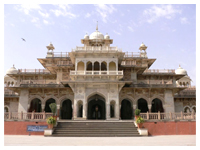 |
Jantar Mantar:
It is one of the five observatories in India and was built by Maharaja Sawai Jai Singh. Jai Singh named his observatory Jantar Mantar, which is actually pronounced, as 'Yantra Mantra', yantra for instrument and mantra for formula.Providing an insight into the fields of numerology and astronomy, it houses ancient astronomical instruments chiseled out of stone. The most interesting instrument here is the Sundial. The shadow cast on it helps in the determination of local and meridian pass time. Besides, varied attributes of the heavenly bodies can also be calculated with the help of it.
The observatory consists of fourteen major geometric devices for measuring time,predicting eclipses, tracking stars in their orbits, ascertaining the declinations of planets, and determining the celestial altitudes and related ephemeredes. Each is a fixed and 'focused' tool.
Each instrument Built of local stone and marble and carries an astronomical scale, generally marked on the marble inner lining; bronze tablets, all extraordinarily accurate, were also employed. Thoroughly restored in 1901, the Jantar Mantar was declared a national monument in 1948. Timing 9.00 to 16.30 hrs, Phone:+91-141- 2610494
|
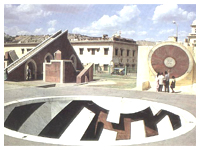 |
Bm Birla Planetarium:
The Birla Planetarium is at the BM Birla Science & Technology Center, near Statue Circle. The Planetarium offers unique audio-visual educational and entertainment with its modern computerized projections system. Timings: 11.00, 13.00, 15.00, 17.00, 18.00, 19.00 hrs. Phone: +91-141-2381594
|
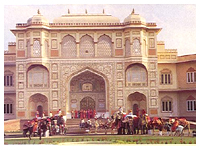 |
Birla Temple:
A small palace, this is a replica of a Scottish castle, and perches on a hilltop. Once occupied by Maharaja Madho Singh's son who was confined here, it was also for a while home to Maharani Gayatri Devi. Entry is prohibited.
At the foot of Moti Dungri fort is the Birla Lakshmi Narayan Temple. It is a large, modern marble edifice.
| 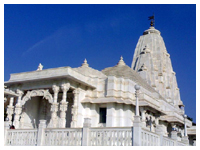 |
Kanak Valley:
Situated on the foothills of Nahargarh Hills, these are beautiful landscaped gardens with an intricately craved temple made of beige stone. The sprawling complex is laid with terrace sites, marble columns and lattices. This complex is a popular spot for picnic and film shoots. The ideal time to be around here is during monsoon, as it sparkles after being washed from the rain water.
The greenery after the monsoons give this whole place a feel of heavenly sensation, with Jal Mahal in the background.Visiting Hours: 0800 - 1700 Hours for garden and 0800-1900 Hours for the temple.
|
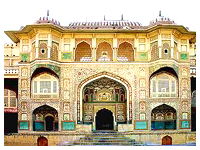 |
JALMAHAL:
(6 kms) on the way to Amer, this small palace is set in the middle of Man Sagar Lake.
Built in the year 1799, with red sand stones, this Water Palace is a quixotic place. The unruffled water of the lake reflects the elaborate carvings make a fabulous spectacle one could ever dream of. A five-storied building, its first four floors are under the lake and only the top floor is seen above the lake. The palace also offers the enchanting scenery of migratory and other exotic verities of the chirping flock. Renovation around the lake is in progress.
There are a number of other tourist attractions in Jaipur that include GAITOR VIDHYADHAR GARDEN, ISHWAR LAT, and DOLLS MUSEUM. Many hotels in Jaipur provide cultural programmes that include puppet shows, music performances and folk dances that make Jaipur tour a memorable affair for tourists
|
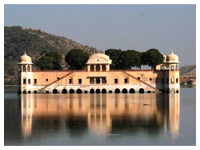 |
|
|

